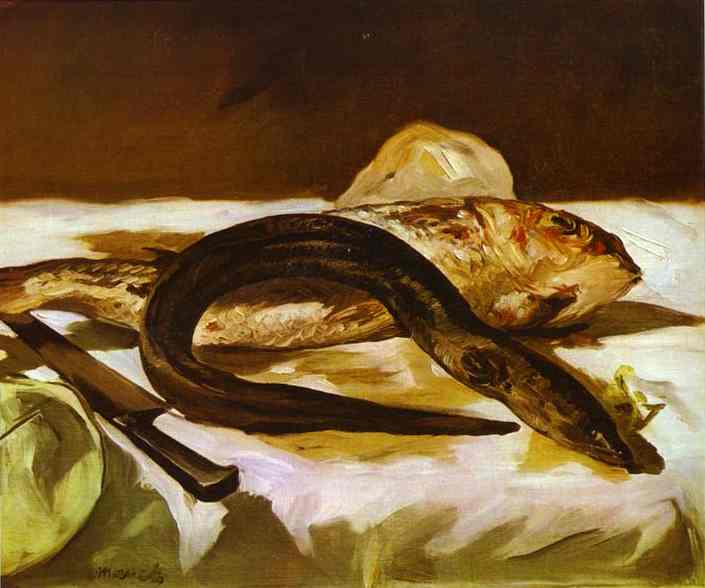תיאור
The painting "Eel and Mullet", created by Édouard Manet in 1864, is a work that encapsulates the artist's mastery in the representation of still lifes and his ability to play with light and the texture of objects. This work, which reflects the transition from traditional academicism to modernity, is located in a context where Manet was beginning to explore new themes and techniques at a crucial moment in French art.
The composition of the work is simple but effective. In the centre, the two fish, an eel and a red mullet, take centre stage, presented in a naturalistic arrangement that invites the viewer to explore their shape and colour. The attention to detail is evident; the eel, with its shiny, scaly skin, and the red mullet, with its vibrant reddish hues, show Manet’s technical skill in depicting the light reflecting off their surfaces. Moreover, the choice of these two elements of the sea is no coincidence; both fish symbolise the richness of Mediterranean gastronomy, an interest in quality and freshness that resonated with the Parisian culture of the time.
The background of the work is equally significant, featuring a dark tone that highlights the vividness of the fish's colours. This contrast between the central subject and the background allows the viewer's attention to be directed without distraction towards the arrangement of the elements. The light, carefully distributed, creates a three-dimensional effect that sees the fish almost leap out of the canvas, a phenomenon that Manet mastered with mastery. Through his treatment of colour and light, the artist establishes a subtle dialogue between truthful representation and a certain stylisation that anticipates modern currents of art.
A notable aspect of "Eel and Mullet" is the absence of human figures, which makes the work an exercise in observation and contemplation of nature, a trait that is associated with the development of still life in modern art. Unlike other Manet works of that time that often present social interactions or characters in a context of everyday life, here silence and stillness allow the viewer to reflect on the aesthetics of the object, which departs from the usual dynamism of the art of the time. This choice can be interpreted as a critique or a commentary on modernity and consumption.
Manet, recognised as a precursor of Impressionism, found in this work a space in which to combine traditional technique with a fresh approach. His use of light colour and loose brushwork, characteristics that would be emphasised in his later works, already begin to emerge in this painting. The work not only falls within the practice of still life, but also allows us to glimpse a sense of immediacy and of capturing a fleeting moment, which would later be defined as a fundamental principle of Impressionism.
"Eel and Mullet" thus represents an emblematic work of the development of Édouard Manet's style, which not only contributed to the evolution of art in the 19th century, but also invited the public to appreciate the simple but profound pleasures of everyday life. In this sense, Manet does not just paint, but captures the essence of the moment, inviting an appreciation beyond mere representation. The fusion of technique, color and form in this work remains a fascinating point of study that resonates in art history.
KUADROS ©, a famous painting on your wall.
Hand-made oil painting reproductions, with the quality of professional artists and the distinctive seal of KUADROS ©.
Painting reproduction service with satisfaction guarantee. If you are not completely satisfied with the replica of your painting, we will refund 100% of your money.

